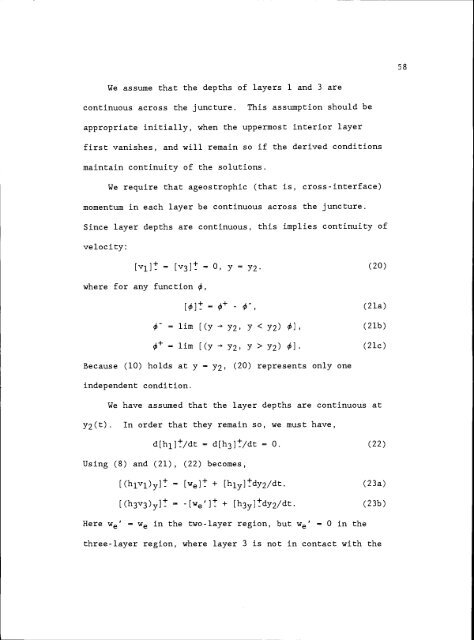Observations and Modelling of Fronts and Frontogenesis
Observations and Modelling of Fronts and Frontogenesis
Observations and Modelling of Fronts and Frontogenesis
You also want an ePaper? Increase the reach of your titles
YUMPU automatically turns print PDFs into web optimized ePapers that Google loves.
We assume that the depths <strong>of</strong> layers 1 <strong>and</strong> 3 are<br />
continuous across the juncture. This assumption should be<br />
appropriate initially, when the uppermost interior layer<br />
first vanishes, <strong>and</strong> will remain so if the derived conditions<br />
maintain continuity <strong>of</strong> the solutions.<br />
We require that ageostrophic (that is, cross-interface)<br />
momentum in each layer be continuous across the juncture.<br />
Since layer depths are continuous, this implies continuity <strong>of</strong><br />
velocity:<br />
[v] = [v3] 0, y y. (20)<br />
where for any function ji,<br />
[]<br />
(2la)<br />
= urn [(y y, y < y2) 1, (2lb)<br />
lim [(y y > y2) ]. (21c)<br />
Because (10) holds at y y, (20) represents only one<br />
independent condition.<br />
We have assumed that the layer depths are continuous at<br />
y(t). In order that they remain so, we must have,<br />
d[h1]/dt d[h3]t/dt 0. (22)<br />
Using (8) <strong>and</strong> (21), (22) becomes,<br />
[(huvl)yit = [we] + [hlylidy2/dt. (23a)<br />
[(h3v3)y] (We'1 + [h3y]1dy2/dt. (23b)<br />
Here We' We in the two-layer region, but We' = 0 in the<br />
three-layer region, where layer 3 is not in contact with the<br />
58















